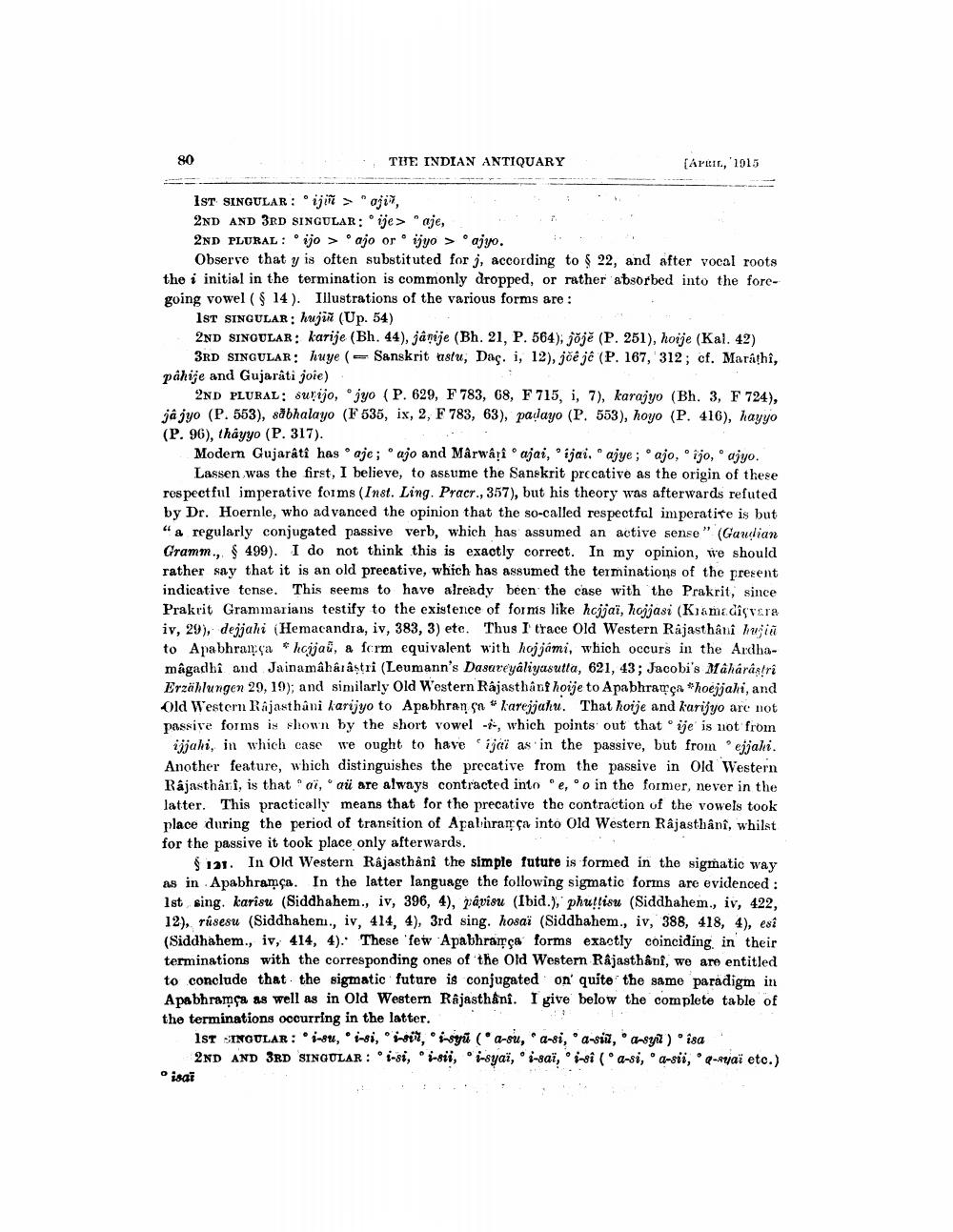________________
80
'
TUE INDIAN ANTIQUARY
[APLIC, '1015
IST SINGULAR : ijit > "aji, 2ND AND 3RD SINGULAR: °ije > "aje, 2ND PLURAL : ijo > ajo orijyo > ajyo.
Observe that y is often substituted for j, according to $ 22, and after vocal roots the i initial in the termination is commonly dropped, or rather absorbed into the foregoing vowel ( $ 14). Illustrations of the various forms are :
sous forms are: IST SINGULAR: hujan (Up. 54) 2ND SINGULAR: karije (Bh. 44), janije (Bh. 21, P. 564), jõjě (P. 251), hoije (Kal. 42)
3RD SINGULAR: huye ( Sanskrit bastu, Dac. i, 12), joé jé (P. 167, 312; cf. Marathi, påhije and Gujarati joie)
2ND PLURAL: surijo, jyo (P. 629, F 783, 68, F 715, i, 7), karajyo (Bh. 3, F 724), ja jyo (P. 553), sabhalayo (F 635, ix, 2, F 783, 63), padayo (P. 553), hoyo (P. 416), hayyo (P. 96), thâyyo (P. 317).
Modern Gujarati hasaje; ajo and Marwari ajai, ijai. ajye; ajo, ijo, ajyo.
Lassen was the first, I believe, to assume the Sanskrit prccative as the origin of these respectful imperative forms (Inst. Ling. Pracr., 357), but his theory was afterwards refuted by Dr. Hoernle, who advanced the opinion that the so-called respectfal imperatite is but "& regularly conjugated passive verb, which has assumed an active sense" (Gaudian Gramm., 499). I do not think this is exactly correct. In my opinion, we should rather say that it is an old precative, which has assumed the terminations of the present indicative tense. This seems to have already been the case with the Prakrit, since Prakrit Grammarians testify to the existence of forms like hojjai, hojjasi (Kjama disvara iv, 29), dejjahi (Hemacandra, iv, 383, 3) ete. Thus I trace Old Western Rajasthani hujú to Apabhrança hojjai, a fcrm equivalent with hojjami, which occurs in the Ardhamagadhi and Jainamaharastri (Leumann's Dasareyaliyasutta, 621, 43; Jacobi's Maharastra Erzählungen 29, 19); and similarly Old Western Rajasthanf hoije to Apabhramça "hoejjahi, and Old Western Rajasthani karijyo to Apabhran sa karejjahu. That hoije and karijyo are not passive forms is shown by the short vowel ---, which points out that ije is not from
ijali, in which case we ought to have jai as in the passive, but from ejali. Another feature, which distinguishes the precative from the passive in Old Western Rajasthari, is that ai, ai are always contracted into "e, o in the former, never in the latter. This practically means that for the precative the contraction of the vowels took place during the period of transition of Apalhrar ça into Old Western Rajasthânî, whilst for the passive it took place only afterwards.
191. In Old Western Rajasthani the simple future is formed in the sigmatic way as in Apabhramça. In the latter language the following sigmatic forms are evidenced : 1st sing. karisu (Siddhahem., iv, 396, 4), pavisu (Ibid.), phullisu (Siddhahem., iv, 422, 12), rúsesu (Siddhaheni., iv, 414, 4), 3rd sing. hosaï (Siddhahem., iv, 388, 418, 4), esi (Siddhahem., iv, 414, 4). These 'few Apabhraça forms exactly coinciding in their terminations with the corresponding ones of the Old Western Rajasthani, we are entitled to conclude that the sigmatic future is conjugated on quite the same paradigm in Apa bhramça as well as in Old Western Rajasthani. I give below the complete table of the terminations occurring in the latter.
IsT SINGULAR : i-u, insi, nein, s-syū (a-su, a-si, a-sin, ay isa
2ND AND 3RD SINGULAR : i-si, s-sii, i-syaï, s-saï, ° s-si (a-si, a-sii, oq-ovaï etc.) °isai




